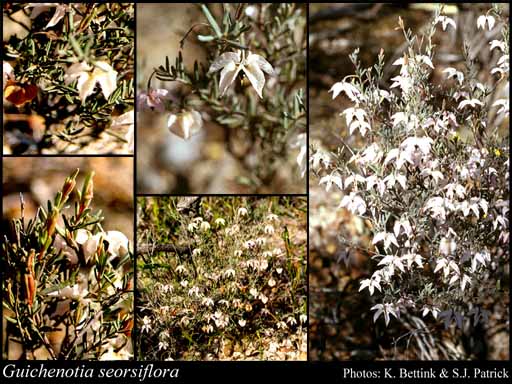- Reference
- Austral.Syst.Bot. 16:355-356,Fig.15 (2003)
- Conservation Code
-
Threatened
A taxon name retains its ‘Threatened’ status until a new name has been officially endorsed and appears in the Gazettal Notice.
- Naturalised Status
- Native to Western Australia
- Name Status
- Current
Multi-stemmed shrub, to 0.6 m high. Fl. pink/pink-cream, Jul to Sep. Sandy clay with lateritic gravel. Breakaways.

Scientific Description
Shrub, with hairy stems. Leaves 5-12 mm long, 1-1.5 mm wide, not lobed; margins entire; hairy, with stellate hairswith scales absent, Sessile glands absent; stipules present and persistent to older leaves. Perianth of two whorls but the corolla reduced to small scales or tiny lobes at the base of the ovary. Pedicel present, 10-11 mm long; indumentum present, with stellate hairs present, with scales absent. Epicalyx (extra segments or 'bracteoles' immediately below the calyx) present, 3-4 mm long, the lobes free, indumentum present, simple hairs (without tubercle bases) absent, stellate hairs present, gland-tipped hairs absentwith scales absent, Sessile glands absent. Calyx pink or cream, 10-15 mm long, the lobes fused half or more of their length, Sessile glands absent, simple hairs (without tubercle bases) absent, stellate hairs present, tubercle-based simple hairs absent, gland-tipped hairs absent, scales absent, Terminal appendages absent, number of ribs present, three. Corolla 1-1.7 mm long, hairs or scales present, simple hairs (without tubercle bases) absent, stellate hairs present, tubercle-based simple hairs absent, gland-tipped hairs absent, scales absent. Indumentum (outside) Sessile glands absent. Stamens five, free and inserted at the base of the ovary; filaments present, 0.2-2.2 mm long; anthers 3-4.5 mm long, indumentum absent (anthers glabrous). Staminodes absent, appendages absent. Ovary hairs or scales present, simple hairs absent, stellate hairs present, gland-tipped hairs absent; style 1, with a lobed or capitate stigma, 2-2.4 mm long, with one style branches or lobes, hairy for most of length, wing absent. Flowering time July, August or September. Distribution Botanical Province South-West, IBRA Bioregion Avon Wheatbelt. Conservation Code Threatened (T).
Distribution
- IBRA Regions
- Avon Wheatbelt, Mallee.
- IBRA Subregions
- Katanning, Merredin, Western Mallee.
- Local Government Areas (LGAs)
- Corrigin, Cunderdin, Kellerberrin, Kulin, Quairading, Tammin.